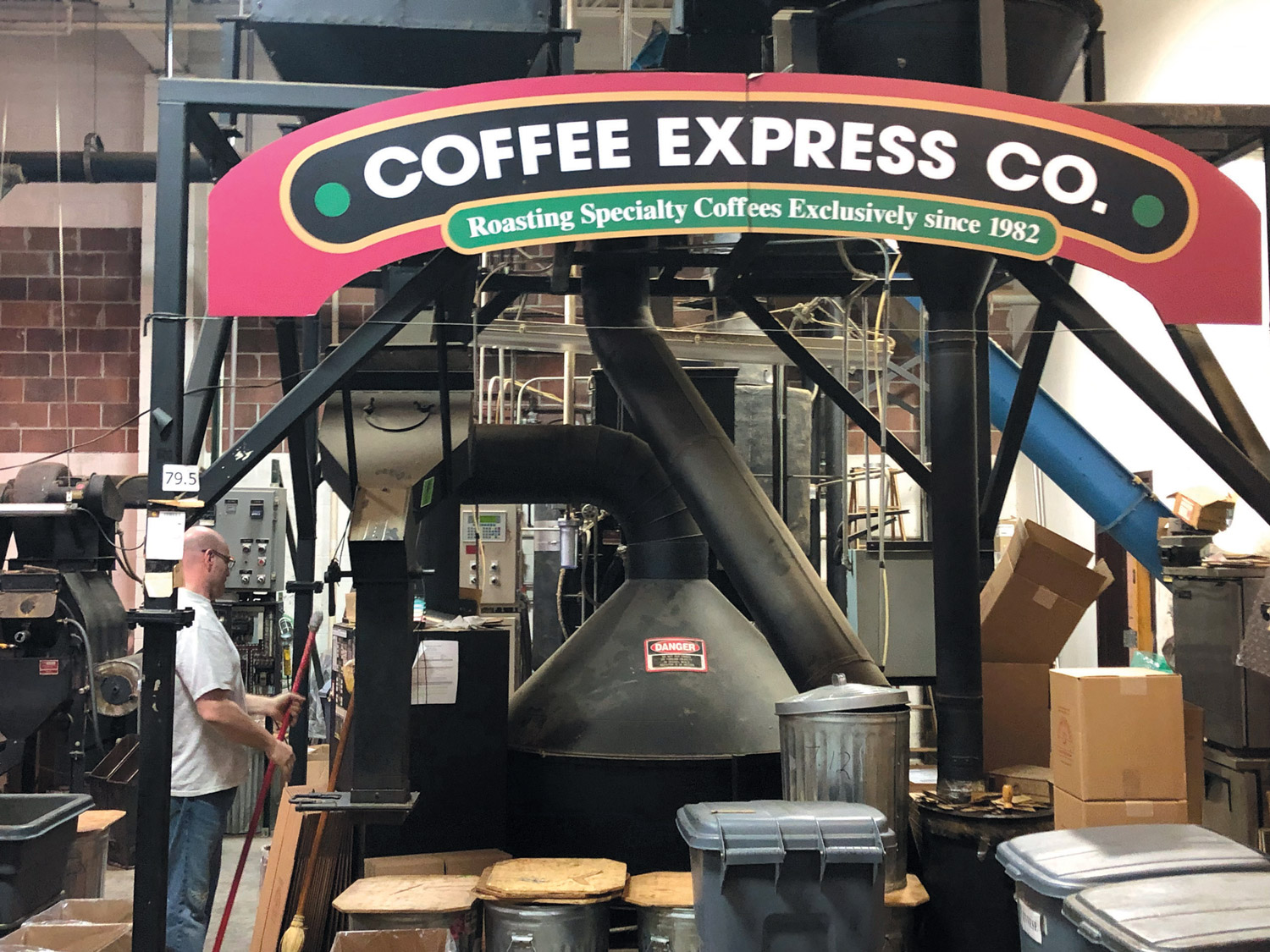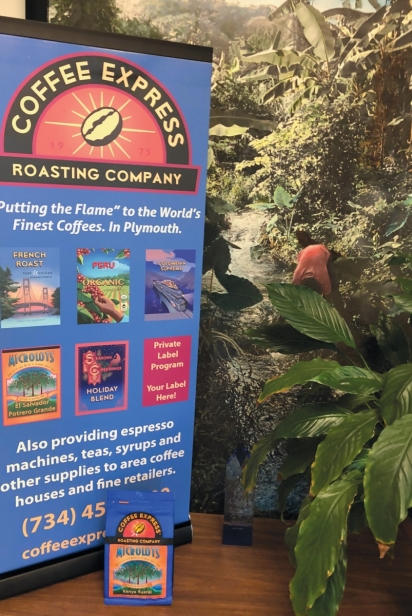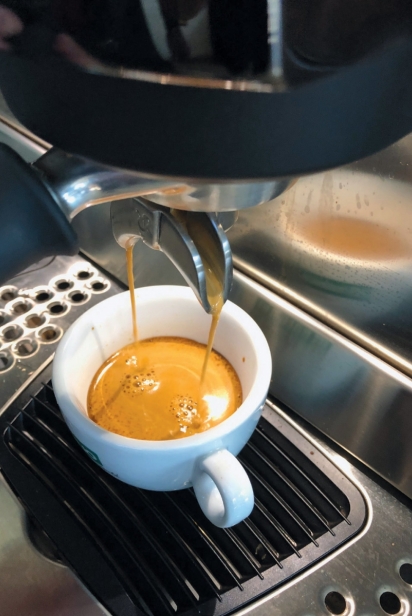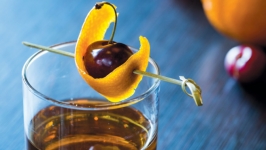The Tom Isaia Story
“Open to all parties, but influenced by none.”
—1770 American newspaper publisher and author Isaiah Thomas
Native Detroiter Tom Isaia could well have adopted this motto as his mantra for the full circle of businesses he has created serving Ann Arbor and Detroit for close to five decades. From opening his iconic Ann Arbor coffeehouse, The Blind Pig, in 1971, through the past 37 years of operating his Plymouth-based coffee-roasting business, Coffee Express, to now launching his newest enterprise, an Italian-style gelateria in Detroit, Tom has focused on building community with open doors—his own way.
“I’m big about people getting along,” he explains. “Everyone has their personal ideas about this and that, but that doesn’t mean you can’t enjoy each other’s company. If you can have a gathering place where people truly enjoy each other’s company, you’ve got yourself a pretty successful place.”
As anyone who has worked with Tom over the years or knows him well can tell you, Tom Isaia marches to his own drum. And while Tom resists crediting his Italian-Sicilian ancestry with influencing his lifelong love of espresso and now gelato, he will give a firm nod to his Detroit roots. “I’m a Detroit kid. Pure and simple.”
Tom grew up in the 7 Mile and Livernois area, often called “The Avenue of Fashion” near Palmer Woods and Sherwood Forest. The youngest of four children, he lived his entire childhood until leaving for college in the same Tudor-style house with a cedar shingle roof, stained glass windows and textured plaster walls that his parents bought in 1937. He also admits that his lifelong interest in all things mechanical, from espresso machines to gelato-making machines, began at home.
“We had a boiler. I loved how you can take water and heat it up and it turns into steam and goes up into the radiators. And then as it hits the cast-iron pipes it condenses as it cools, and turns back into water that naturally goes back into the boiler through the same pipes—and it just keeps that going forever.”
Tom started drinking coffee at an early age—between 5 and 7, he remembers. His father, Frank, would get up every morning and perk a pot of coffee in a stainless steel pot on their stove. He also remembers family summer trips to New Brunswick, New Jersey, where his mother, Mary, had family. There, his aunt would brew coffee in a Silex. Back then, this ’40s-era coffee maker had two glass globes affixed one on top of the other, and the coffee would go in the middle on a thick felt filter. Tom describes the process: “You’d put them on the burner and you’d have watch it carefully, as the water boils. Just like that boiler in my house, the boiling water expands and goes up into the upper vessel, through the coffee. And then you take it off the heat, or you’ll crack the glass boiler. Almost immediately, the bottom becomes a vacuum as it cools down, and the negative four pounds or so of pressure draws the coffee back through the filter. So you’ve got a stronger cup than you have now with an automatic drip machine.” He laughs that it also certainly took more attention than the now-popular automatic K-cup, where you simply push a button and walk away.
Another possible influence on Tom’s entrepreneurial future was the family’s dedication to business enterprises. Frank, a barber by trade, bought land in Southfield in the early 1960s and built a four-business building. He had his barbershop; Tom’s mother opened a beauty salon; brother John had a TV repair shop—and they rented out the fourth space to a restaurant called the Purple Pickle. Owning small businesses was a family affair.
The Early Ann Arbor Years It was when Tom left home for Chicago to attend Loyola University, continuing his Detroit years of all-Catholic schooling, that he found the path to his calling. While just a sophomore at Loyola, he got permission to attend their Junior Year Abroad in Rome, Italy. After a full school year in Rome, absorbing the rich Italian café culture along with his studies, he found another school to attend in Tokyo for his junior year before finally returning to Michigan, landing at the University of Michigan in Ann Arbor for his senior year. That was when he began to conjure up his idea for The Blind Pig.
“So I came back from two years overseas and started going to Mr. Flood’s Party,” Tom relates. “It was a completely new thing. They had music every night. It was lively, it was packed and it represented a new era.” A sharp departure from Ann Arbor’s “shot and beer” bars, Mr. Flood’s was a self-described hippie bar where, according to Tom, “People hung out and had a good time. And having a good time is kind of the bottom line. I wanted to do a European-style café, but I wanted it to be like Mr. Flood’s.” With his brother John helping with initial financing as a silent partner, Tom persuaded his close friend from his Loyola Rome year, Chicagoan Jerry Del Giudice, to move to Ann Arbor with his new wife and baby. Together they created The Blind Pig as a wine-and-cheese café with music, opening its doors in 1971. Tom and Jerry’s commitment to serving high-quality items—fine wines and liquors, select beers, apple cider from Alber Orchard near Manchester and milk from a small dairy farm in Stockbridge—and featuring bona fide Detroit blues musicians made The Blind Pig a popular gathering place for all kinds of people and one of Ann Arbor’s original coffeehouses.
From Coffeehouse to Coffee Roaster European-style coffee became a Blind Pig hallmark with the espresso machine that Tom installed there from the beginning, in lieu of a regular coffee maker—offering up espressos and lattes for 25 cents. He found it (pre-internet) via a Manhattan telephone book’s Yellow Pages in the Ann Arbor Public Library and bought his first machine, along with coffee, from New York City. And in 1975, Tom started placing espresso machines in other places around Ann Arbor and Detroit. After Tom and Jerry sold The Blind Pig in 1979, Tom opened a storefront on Ann Arbor’s east side across from Arborland as Coffee Express, selling espresso machines—primarily the Rancilio brand—for home and commercial use, some of which are still used today by his earliest customers. Retired University of Michigan art professor Vince remembers fondly, “I bought that Rancilio from Tom over 22 years ago—it’s working fine. Never had to service it.”
Tom’s initial idea of taking the espresso-selling business national and establishing service outposts in 12 to 13 regions, while prescient, was also going to take some money and a lot of travel time away from his growing family. “So I decided to roast coffee instead,” he explains. “I had fairly mastered espresso machines and it was time to put really good coffee in them.”
Following the lead of the nascent specialty coffee movement happening then in New York City and San Francisco, Tom saw the potential for creating a market for locally roasted specialty coffee. “Ann Arbor and Detroit had a couple of stores that sold fancy coffee. Big Ten Party Store in Ann Arbor was like a breakthrough in having high-quality stuff back in the late ’60s.” But none of these stores were getting their coffee roasted locally. There were a handful of regional roasting companies around but most had been swallowed up by the much larger national companies during the ’70s and ’80s era of brand consolidation. So in 1982, Tom opened Coffee Express Roasting Company on North Main Street in Ann Arbor and quickly became an integral part of the local retail specialty food scenes in Ann Arbor and Detroit.
With demand growing, in 1997 Tom moved his operation to Plymouth to accommodate additional roasters and increased roasting capacity and warehouse space. At any given time the 9,000-square-foot roasting facility there is filled with a cacophony of sounds and aromas from the three primary roasters (two that he brought from the Ann Arbor location—a Buffalo-built Jabez Burns and a German-built Probat—and a much larger two-bag Jabez Burns that he bought after the move). In addition to the many pallets piled high with burlap bags of green coffee beans from all over the world, more than 40 bins of individual freshly roasted varietals fill the space along with shelves of added-value products including tea and flavoring syrups and a section for packaging and labeling the outgoing coffee—delivered daily by two bright red delivery trucks.
Steven Kahn, former grocery manager at The Produce Station for 25 years, was an early customer. “We grew our businesses together,” he recalls fondly. “Tom was local and he did twice-a-week deliveries. And he was also a regular customer of ours. But mainly, he really knew his stuff.”
That sentiment is echoed today by Jordan Pruett, general manager of Atomic Coffee in Royal Oak, a customer since it opened in 2015. “They are one of the best in the business. Through Coffee Express I can get really great coffee from nearly any coffee-producing country in the world. I can count on Tom to source fantastic single-origins and microlots for a truly unique coffee experience. Plus working with Tom and his team, I can create one-of-a-kind custom blends that our customers love.”
Jordan remembers when Tom bought his fifth roaster, a Dutch-built Giesen. “We spent an entire day together roasting small batches of beans so we could determine the perfect way to roast that particular varietal and shared stories of our favorite coffee experiences we’ve had over the years. Tom has helped me better understand the process of roasting the coffee as well as understanding coffee as a crop, a commodity, a necessity.”
Recently returned from a trip to visit some of his coffee purveyors in Costa Rica, Tom says of his relationships with his suppliers: “A lot of that is personal.” Most importantly, he emphasizes, “You have to know who you’re dealing with. These are personal relationships. So I value that. My wife, Ruth, and I both like to travel but we don’t like to ‘sightsee.’ We just like to visit people, because that’s what the fun in life is.” And the same sentiment extends to his customers, “It makes doing business worthwhile when you have customers who are just good people and they like your product. That really does just make the day, make the month, make the year.”
Not surprisingly, the nine-person staff at Coffee Express operates as family. Scott Novak was Tom’s first employee and has worked there for over 30 years. Jeff Dout is Coffee Express’s newest employee of just over six-months and says, “I can’t say that I’ve ever had a job that was this much fun.” Office administrator Genevieve Boss adds, “I like that it’s a small company and most of us have been here for a very long time.” Asked what family member she would be, she laughs, “I’d be the crazy aunt.”
Coming Full Circle with Momento Gelato Inside Tom’s new gelato-making room at Coffee Express, a whole new enterprise is taking off. This room is in sharp contrast to the gritty and aromatic roasting and warehouse areas that surround it. Sparkling white tile and soft pink walls are backdrop for his shiny new gelato-making machine and the freezers packed with hundreds of containers of made-from-scratch gelato, featuring flavors like Salted Caramel, Lemon Custard, Hazelnut and Dark Chocolate. The Cattabriga gelato machine is imported from Bologna, Italy, where Tom trained with experts on the culinary art of gelato-making during two trips that he made there in 2017. Tom explains that Cattabriga made their first gelato machines in 1927—the same year that Rancilio made their first espresso machines. Tom says, “We use both of those companies now. Must be something about 1927!” And that is just one link that connects Tom’s coffee and gelato.
In Italy coffee and gelato go hand-in-hand. Tom doubts that there is any Italian gelateria without an espresso machine. Unbound by the USDA rules that govern ice-cream making, gelato is typically made a mano (by hand) and can have a wide range of butterfat content and little air (ice cream must have at least 10% butterfat and can have as much as 50% air in it). Gelato is typically creamier and denser than ice cream as a result.
Having more room to experiment with flavors and mouthfeel appeals to Tom’s love of conjuring up pleasurable experiences. And creating pleasurable experiences is what motivates his new venture. “There’s something about mixing ingredients with sugar and being cold. It just really tastes good,” he explains. Even the name for his new product, Momento Gelato, comes from the first day during his training in Bologna when Tom’s mentor, Giacomo, told him that gelato is “a moment of pleasure.” Tom says, “Gelato puts a smile on people’s faces. It’s a nice community thing.”
Coming full circle back to his Blind Pig days by creating a new community space—this time around gelato and coffee, Tom says that plans are in the works to open an Italian-style gelateria in downtown Detroit. In the meantime you can find Momento Gelato in locations around Ann Arbor such as Downtown Home and Garden and The Produce Station, and in the Detroit area at Market Square and Market Fresh in Southfield and Birmingham and Morning Glory Caféin Grosse Pointe. But having a gelateria is what will really allow Tom’s vision to soar—a gathering place where people can truly enjoy each other’s company and “open to all.”
Coffee Express Roasting Company
47722 Clipper St., Plymouth
734-459-4900; CoffeeExpressCo.com
A Coffee Q&A
What goes into making a good cup of coffee?
Tom: Coffee grows as a bush. And it flowers. Then that flower turns into a green bean, or cherry. As it reddens, it becomes ripe and is ready to pick. Inside are two seeds, or the pits, which is the coffee—after the mucilage or the cherry is discarded. A lot of factors go into growing the coffee: the husbandry of the plant, the species or the cultivar that you’re using, the soil composition, how much rainfall and what side of the mountain it’s on. The farmer can match the right plant, the right cultivar, to the land. And how the mucilage is removed, whether you dry it first or wash it first. All that is huge—it influences the taste of the coffee in large measure. So then the coffee gets to a roaster, who chooses the method, temperature and timing to create different strengths, from light to dark. It has to be brewed properly and have the right water temperature. Typically you use hot water at 195 to 200° (remember that water boils at 212°). And then you have to have the right grind. If it’s too coarse for the method you’re using, you don’t get enough extraction; if it’s too fine, you over-extract—you can pull some bitters. There’s hundreds of compounds in coffee. And then, how fresh it is. Whether you grind it right away—what method you use, what’s the best method for the taste you want. All that is part of what makes a good cup of coffee. If you’re a good chef, a good cook, then you understand how to bring a particular coffee up to what you’re looking for.
How much coffee is grown worldwide?
Tom: The world produces about 50 million 140-pound bags of green coffee beans per year. Everybody around the world drinks coffee! But not that much—only about a pound of finished coffee—comes off a single bush. Arabica yields less than Robusta.
What is the difference between Arabica and Robusta?
Tom: Arabica is what most people drink, the quality coffee. Robusta is more of a filler—it’s cheaper and grows more easily at lower altitudes. And it is also more resistant to disease. But the taste isn’t so hot. So it’s not used in specialty coffees or coffeehouses. However, in the larger coffee industry it can be used as much as 80 percent. Maybe half of the large commercial coffees are Robusta. It has a taste you can identify with what you’d call “institutional” coffee. There’s a lot of Robusta grown. Robusta is good for the coffee industry in one way in that it keeps the price down to the consumer, because it helps with the volume. An interesting fact: Italians created the world of espresso cafés and coffeehouses. But typical Italian espresso can be 60–70 percent Robusta. So when you go to Italy and fall in love with espressos, you mostly like them because it was fun to be in Italy. But if you went to any renowned café in Denver or Detroit and you ordered an espresso and it tasted like that, I don’t think you’d enjoy it. Just put a lot of sugar in it! So we mostly use Arabica here for that.
Light or dark roast?
Tom: A lot of people like dark roast. The trend is to have not such dark roasts. But that doesn’t stop 30–40 percent of the country’s specialty coffee drinkers preferring something a little darker. However, the day you start pontificating and saying that this is the way it’s supposed to be or that we roast to the sweet spot for whatever coffee we bring in, you’ll regret it. Because the sweet spot is subjective—it’s all subjective. But you can ruin a good coffee.
What is your favorite coffee to drink?
Tom: I like the Central American coffees. They have the brightness and some more characteristic body and chocolate. More mouth appeal. But East African coffees are terrific too. I typically like coffees that are sweeter. Not everybody looks for the sugars in coffee, but when a coffee’s got a sweet and nutty flavor, that would be my favorite. Someone gave me a Nicaraguan coffee one time that tasted exactly like blueberries.
Three Ways to Brew Coffee
Drip Brewing
• Auto-Drip Use medium grind and fresh cold water. Measure to taste, but the rule of thumb is a heaping tablespoon for every six ounces of water. Or two to two-and-a-half weighed ounces for 48 fluid ounces water.
• Hand-Pour There are a few types of popular hand-pour systems, such as Melitta, Chemex and V60. Use the proper filter and note that each system has its own paper style. We use Chemex at Coffee Express and measure 48 grams of medium-ground coffee to 800 grams water. Pre-wet the filter and holder (dripper) with hot water and discard water. Measure in your ground coffee. Pour some hot water (195–200°) and wait 30 to 40 seconds. Start pouring water every 30 seconds or so until you get to the 800 grams. Process shouldn’t go over four minutes—if it does, the grind may be too fine.
French Press
Use the same ratios of coffee as in drip. Grind can be slightly coarser than the drip. Pour the recommended temperature water, 195–200°, on the coffee in the pot. Wait three or four minutes. Plunge metal screen down. Note: Stirring with a spoon after pouring the water can make the plunging easier.
Espresso Machine
• Stovetop The Bialetti Moka pot is difficult to use, but fun. Pack finely ground coffee in the middle. Use cold water and heat while monitoring closely the whole time. You can start with a slightly higher temperature, then turn down heat as the coffee starts to come up to the top chamber. Take off heat immediately after the coffee has filled the top chamber and is no longer percolating up.
• Espresso Machine Each model will demand a different approach, so follow machine instructions. For all machines, fill basket with finely ground coffee. The object is to have the machine build pressure and push the hot water against the resistance the finely ground coffee provides. You always want a small, thick stream of coffee to fill your cup.









